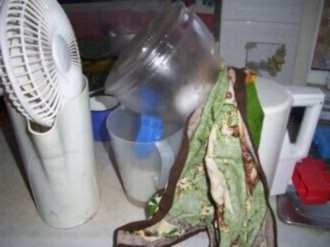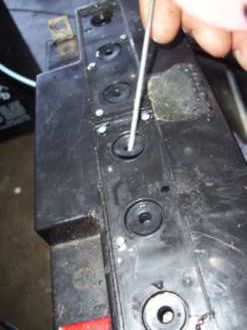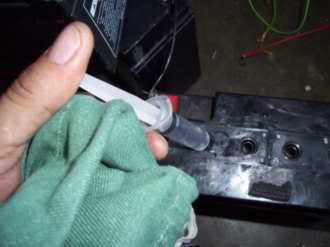I have these old 18 amp hour batteries that were used on an old brushed chain drive bike, and I used two of these on my new bike when it was attacked by some doche in town.
I found a hole in one and this battery was dicharging on a 50 watt lamp within 4 minutes. So I patched the hole and decided to see if I could bring all of these batteries back up to speed.
Firstly I had no cash left to my name and with no rain in site, I needed a source of distilled water, you can buy this stuff for a song at the supermarket but to make thing a lttle interesting I decided to make my own.
1 kettle
1 kids building block to balance the pyrex pot
1 ceramic cup to catch the water
1 plastic measuring container to hold the block, cup and balance the pyrex pot.
1 syringe
1 plastic fork to turn the kettle on and off because it got to steamy and a little shocking

1 tea towel to seal the kettle to the pot
1 fan to cool the the pyrex pot..

Hehehe
This looks a little expensive but I only needed a lttle bit and it only took me about 15 minutes of switching the kettle on and off to get the optimum temperture for maxium water production, that pyrex pot gets a little hot and the water stops dripping so a fan to help cool it helped a lot...
Umm I estimated about 20 cents it cost me. a dime!
The more I made of this stuff the better it got. I used an syringe we use for kids panadol.

You need to remove the tops off the the SLA batteries and underneath you will find the seals and absorbant matting.
Remove the seals and inside is where they use (soaking medium) gel or fibergalss matts to hold the water acid solution up against the plates.

Take a torch and look inside the cells and you will get and idea how much you need to add. You don't want to fill the cells up to the top just up to the plates and the medium inside. The acid will spew out of the top after a good charge if you over fill them.
When you fill each the cells you will see the the water reflect just above the soaking medium, this is just right.


When you put this back all together you will need to put all the sealer caps on glue the sealer plate on top as when you charge the batteries the caps will pop off and go missing. Try not to leave the battery without the seal caps in place as you don't want any debris getting inside and fouling your acid solution.
It all went well I did a couple of discharges with the lamp and hooked a bushed motor up to get rid of some memory voltage and soon enough I was getting the bad battery to take a quick charge up to two hours. Leaving these on float charge over night isnt going to hurt them..
Last time I checked them with the lamp as my cheapo multimeter is palying up, I could not tell the brightness difference between the good batts and the one that was discharging with in 4 mins, Ill do a proper run on the brushed motor bike tomorrow and see if I get most if not all of the capacity back...